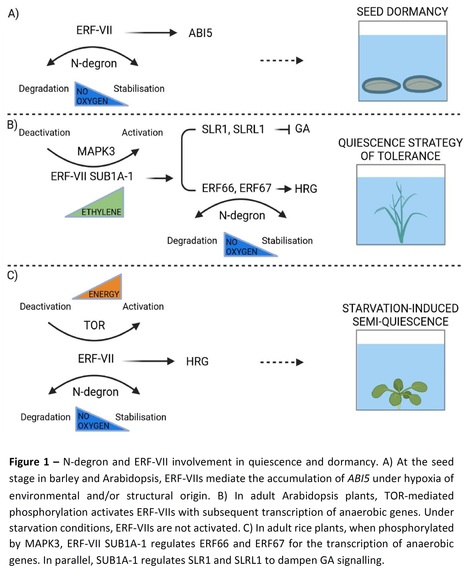Authors: Md Ibrahim Khalil, Md Mahmudul Hassan, Swadesh Chandra Samanta, Abul Kashem Chowdhury, Md Zahid Hassan, Nasar Uddin Ahmed, Uzzal Somaddar, Sharmistha Ghosal, Arif Hasan Khan Robin, Ujjal Kumar Nath, Mohammad Golam Mostofa, David J. Burritt, Chien Van Ha, Aarti Gupta, Lam-Son Phan Tran and Gopal Saha.
Plant Physiology and Biochemistry (2024)
Highlights • Rice plants having SUB1A-1 endure submergence through a quiescence strategy. • SUB1A-1 mediates inhibition of levels and signaling of ethylene, gibberellin and auxin. • SUB1A-1 increases brassinosteroid biosynthesis and signaling, and JA responsiveness. • SUB1A-1 activates leaf gas film formation and reduces carbohydrate catabolism. • Submergence-tolerant wild rice genotypes lack SUB1A.
Abstract: "The world's low-lying rice (Oryza sativa) cultivation areas have been suffering from the threats of submergence or flash flooding due to global warming. Rice plants manifest a variety of physiological and morphological changes to cope with hypoxia and underwater adversities, including lowering carbohydrate consumption, inhibiting shoot elongation, and forming thicker leaf gas film during submergence. Functional studies have revealed that submergence tolerance in rice is mainly determined by an ethylene response factor (ERF) transcription factor-encoding gene, namely SUBMERGENCE 1A-1 (SUB1A-1) located in the SUB1 quantitative trait locus. The SUB1A-1-dependent submergence tolerance is manifested through hormones such as ethylene, gibberellic acid, brassinosteroid, auxin and jasmonic acid. Considerable progress has been made toward the introduction of SUB1A-1 into rice varieties through a conventional marker-assisted backcrossing strategy. Here, we review the recent advances in the physiological, biochemical and molecular dynamics of rice submergence tolerance mediated by the ‘quiescence strategy’. Thus, the present review aims to provide researchers with insights into the genetics of rice submergence tolerance and future perspectives for designing submergence-resilient plants for sustainable agriculture under the uncertainties of climate change."



 Your new post is loading...
Your new post is loading...









